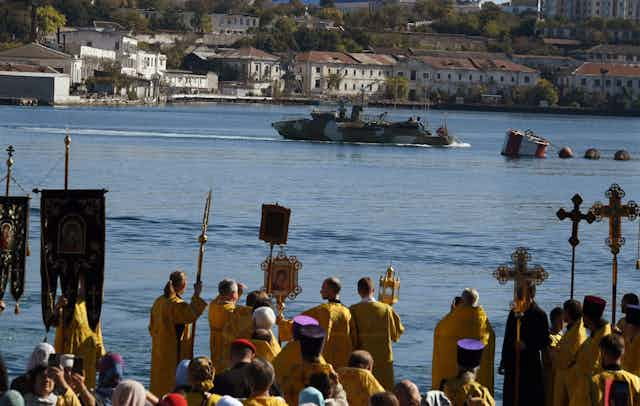With Russia on the offensive around Avdiivka in the east of Ukraine, most commentators’ attention is once again focused on the battlefield on land. But it’s also crucial to keep a close watch on what is happening in the Black Sea.
On October 24, Ukraine’s president, Volodymyr Zelensky, made the claim that: “The Russian fleet is no longer able to operate in the western part of the Black Sea and is gradually fleeing from Crimea. And this is a historic achievement.”
Following attacks on the Sevastopol shipyard on September 13 and on the Black Sea fleet headquarters on September 22, it has been reported that Russia is redeploying key naval assets away from their main base.
The fleet reportedly intends to base itself increasingly in two safer ports: Novorossiysk and Feodosia, on either sides of the Kerch strait connecting eastern Crimea with the Russian mainland. There are even reports of plans to build naval facilities in the breakaway Georgian region of Abkhazia. Whether this is a partial redeployment or a major one, and whether this is a long- or short-term redeployment, this demonstrates a new strategic reality in the Black Sea.
Even without an operational navy, Ukraine can threaten and hit Russian ships as far away as Sevastopol and beyond. Kyiv has developed a credible capability to engage Russia’s naval assets at long distances, using missiles and maritime drones.
This is a major problem for Moscow. Warships are often the most expensive individual military assets in a country’s arsenal. Complex naval vessels can take decades to procure and make operational. For instance, in the UK, the procurement cycle for warships is often considered over a 30-year period.
Reduced capabilities
Russia has a very limited number of warships in the Black Sea, and due to the application of the Montreux Convention by Turkey, Moscow cannot reinforce its Black Sea fleet with warships from its Baltic or Northern fleets.
Read more: What the Montreux Convention is, and what it means for the Ukraine war
Consequently, protecting its remaining assets is a key objective for Russia, since the Black Sea fleet cannot reasonably afford to lose more. That might explain the redeployment. If confirmed, this can be considered a major victory for Ukraine, both at operational and symbolic levels.
As of now and in the foreseeable future, Russia has less capacity to service and repair damaged ships and submarines in the Black Sea. Sevastopol dry docks are currently not fully functioning and the port of Novorossiysk in the eastern Black Sea does not have the same capability, especially for submarines.
With warships requiring regular maintenance – and an indefinite number in need of repair due to the recent attacks – we can expect a backlog to build up. This could be significant if more warships sustain damage in the short-to-mid term.
Thus, the Black Sea fleet will have to be very prudent with its remaining assets, which might result in a reduced number of operational deployments in the foreseeable future. The fewer Russian ships operating in close vicinity to Ukraine, the more room for manoeuvre there is for Kyiv to launch further attacks on Crimea and the Black Sea fleet, contributing to a positive loop of victories and opportunities.
Russia’s limited options
Ukraine has gradually reduced the Black Sea fleet’s ability to contribute to Russia’s war effort such that, effectively, Russia has lost control of the Black Sea. Its surface ships cannot operate safely in the northwestern Black Sea (the area delimited by the triangle between Odesa, Sevastopol and the Ukraine/Romanian border).

Consequently, some operational options are now out of the question for Russia, such as launching an amphibious assault on Odesa, once a key objective. Other options are rendered more difficult, such as implementing a credible blockade on Ukraine’s Black Sea ports.
But Russia’s three Kilo-class submarines can still launch Kalibr cruise missiles against Ukraine’s territory as they remain safely underwater – they have a range of 400 nautical miles when submerged.
End of the blockade a blow for Moscow
Russia’s blockade has lost credibility – and the less credible that threats to maritime trade are, the easier it is for Ukraine to reach agreements with maritime insurers. Moscow knows this, so it has started to disrupt Ukraine’s trade by attacking grain and port facilities on land. Russia might also try to mine trade routes, including safe corridors, using its Kilo-class submarines that have the capacity to lay mines.
The anticipated agreement between Nato members Turkey, Bulgaria and Romania on a minesweeping joint force demonstrates that the priority is now establishing secure sea lanes, to reduce risks and insurance costs and thus normalise grain exports.
If confirmed, this agreement would also be significant from a diplomatic perspective. It would demonstrate that Nato is both willing and able to make sea routes safe without the need to bring further ships into the Black Sea (which would clash with Turkey’s application of the Montreux Convention).
This is a very important and strong political, diplomatic and military statement in favour of the defence of freedom of navigation and upholding freedom of the seas. Indeed, it would demonstrate that there is no going back to the situation when Russia’s threats were credible enough to dictate the terms and conditions of navigation and maritime trade in the region.
For Russia’s president, Vladimir Putin, the recent drawbacks in the Black Sea constitute a political blow. Russia now looks weak in Crimea – which is a big problem, given the central role that Crimea plays in Putin’s imperialist narrative. In other words, there is a symbolic aspect to Ukraine’s success, in addition to the material and operational ones.
For Ukraine’s morale, it is priceless. With Russia launching its strongest land offensive in months and winter approaching, Ukraine getting the upper hand at sea would be significant. Let’s not forget that, historically, maritime preponderance has been a decisive factor in winning long wars.

